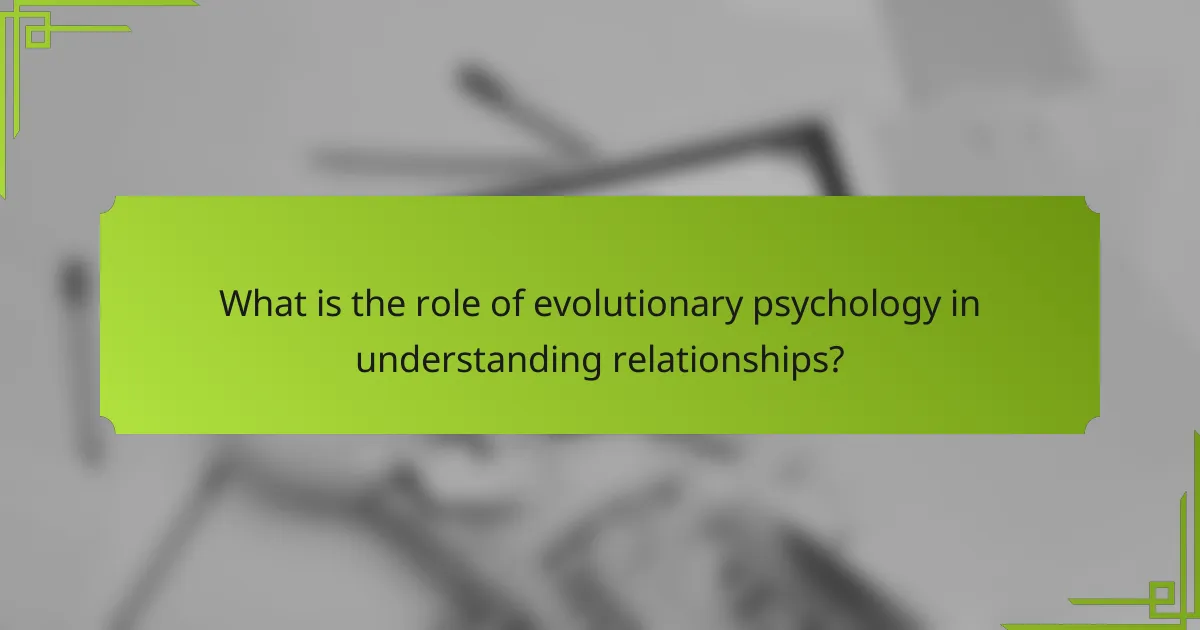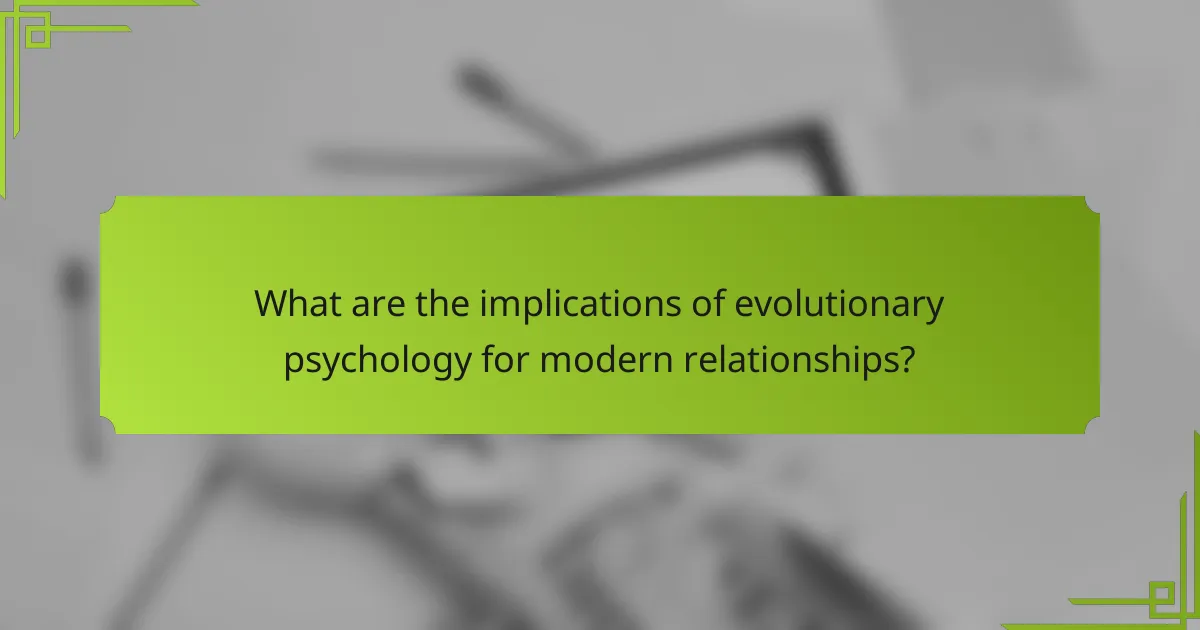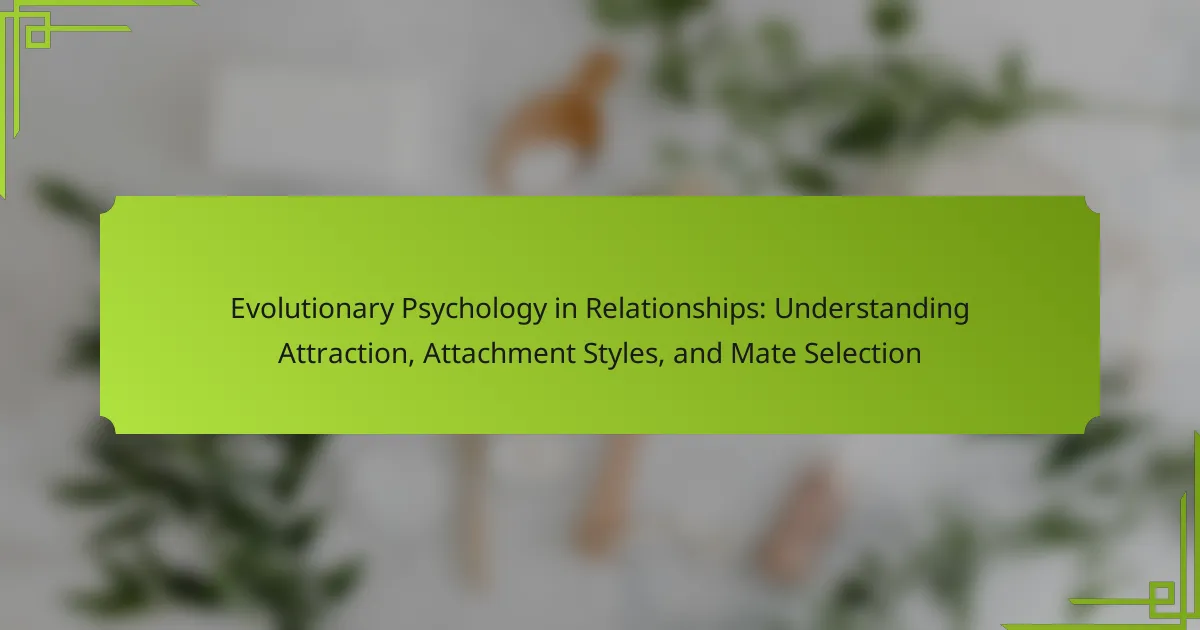Understanding the dynamics of attraction, attachment styles, and mate selection can enhance relationship satisfaction. Evolutionary psychology explains how biological imperatives influence attraction. It also reveals how early experiences shape attachment styles, affecting relationship health. Additionally, mate selection preferences highlight traits that promote stability and reproductive success.

What is the role of evolutionary psychology in understanding relationships?
Evolutionary psychology plays a crucial role in understanding relationships by explaining attraction, attachment styles, and mate selection. It suggests that human behaviours in relationships are influenced by evolutionary pressures.
Attraction is often driven by biological imperatives, such as the desire for healthy offspring. Research indicates that traits like physical appearance and social status can enhance attraction, as they signal genetic fitness.
Attachment styles, shaped by early experiences, influence relationship dynamics. Secure attachment fosters healthy relationships, while insecure styles can lead to challenges. These patterns are rooted in evolutionary survival strategies, ensuring bond formation for mutual support.
Mate selection is guided by preferences that evolved to maximise reproductive success. Factors like resource availability and genetic compatibility play significant roles. Individuals may prioritise traits that promote stability and security in their partners, reflecting evolutionary advantages.
How does evolutionary psychology explain attraction?
Evolutionary psychology explains attraction as a mechanism for reproductive success. It posits that individuals are drawn to traits indicating genetic fitness, such as physical health and social status. This attraction influences mate selection and attachment styles, which are crucial for forming lasting relationships. Research shows that preferences for certain traits can vary based on environmental factors and individual experiences, highlighting the complexity of attraction.
What are the evolutionary factors influencing physical attraction?
Evolutionary factors influencing physical attraction include genetic compatibility, health indicators, and social status. These elements shape mate preferences, ensuring reproductive success. For example, symmetry often signifies genetic fitness, while resources indicate stability. Additionally, cultural influences can modify attraction patterns, reflecting societal values. Understanding these factors enhances insights into human relationships and mate selection processes.
How do social cues impact attraction from an evolutionary perspective?
Social cues significantly influence attraction from an evolutionary perspective by signalling potential mate quality. These cues, such as body language and facial expressions, provide information about health, genetic fitness, and social status. For example, individuals who exhibit confidence through posture and eye contact are often perceived as more attractive. As a result, these social signals play a crucial role in mate selection, guiding reproductive strategies and attachment styles throughout human evolution. Understanding these dynamics helps clarify why certain traits are universally appealing across cultures.
What attachment styles are recognised in evolutionary psychology?
Evolutionary psychology recognises four main attachment styles: secure, anxious, avoidant, and disorganised. These styles influence relationship dynamics and mate selection strategies. Secure attachment fosters healthy relationships, while anxious attachment may lead to dependency. Avoidant attachment often results in emotional distance, and disorganised attachment can create confusion in relationships. Understanding these styles helps explain attraction patterns and relationship behaviours.
How do secure, anxious, and avoidant attachment styles develop?
Secure, anxious, and avoidant attachment styles develop through early interactions with caregivers. Secure attachment arises from consistent and responsive caregiving, fostering trust and emotional safety. Anxious attachment often results from inconsistent caregiver responses, leading to heightened sensitivity to relationship dynamics. Avoidant attachment typically develops from caregivers who are emotionally unavailable, promoting self-reliance and discomfort with intimacy. These patterns influence adult relationships, shaping expectations and behaviours in romantic contexts. Understanding these origins can enhance relationship dynamics and personal growth.
What role do evolutionary pressures play in attachment styles?
Evolutionary pressures significantly shape attachment styles by influencing behaviours that enhance survival and reproduction. Secure attachment fosters trust and cooperation, improving offspring care. In contrast, insecure styles may develop as adaptive responses to environmental challenges, reflecting varying parental investment. Research indicates that these attachment patterns stem from evolutionary strategies that prioritise relationship stability and resource allocation for raising children. Understanding these dynamics reveals how attachment styles are not just personal traits but are deeply rooted in our evolutionary history.
How does mate selection reflect evolutionary principles?
Mate selection reflects evolutionary principles by prioritising traits that enhance reproductive success. Individuals often seek partners with attributes signalling health, genetic fitness, and resource availability. These preferences stem from ancestral environments where survival depended on choosing mates capable of producing viable offspring. As a result, attraction and attachment styles evolve to favour partners who exhibit these desirable traits, reinforcing evolutionary strategies in modern relationships.
What traits are preferred in mate selection according to evolutionary psychology?
Attraction in mate selection often emphasises traits like physical attractiveness, social status, and personality compatibility. Evolutionary psychology suggests these traits signal reproductive fitness and resource availability. Research indicates that men typically prioritise youth and beauty, while women often value stability and resources. These preferences reflect ancestral survival strategies.
How do cultural factors intersect with evolutionary mate selection?
Cultural factors significantly influence evolutionary mate selection by shaping preferences and behaviours. Cultural norms dictate what traits are deemed attractive, impacting mate choice across different societies. For instance, cultures that value collectivism may prioritise familial approval in mate selection, while individualistic cultures may emphasise personal compatibility. Additionally, cultural narratives around gender roles can affect perceptions of desirability, altering mating strategies. As a result, understanding these intersections provides insight into the complexities of human attraction and relationship dynamics.

What are the universal attributes of attraction in relationships?
Attraction in relationships is influenced by universal attributes such as physical appearance, emotional connection, and shared values. Physical attractiveness often initiates interest, while emotional bonds deepen relationships. Shared values align partners, enhancing compatibility and long-term satisfaction. These attributes are rooted in evolutionary psychology, shaping mate selection processes.
How do evolutionary traits shape universal attraction patterns?
Evolutionary traits significantly influence universal attraction patterns by guiding mate selection processes. Traits such as physical appearance, social status, and genetic compatibility shape preferences across cultures. These attributes are rooted in evolutionary psychology, where individuals seek partners that enhance reproductive success. For example, symmetry in physical features often signals health and genetic fitness, making it a unique attribute in attraction. Additionally, attachment styles developed through early experiences affect how individuals perceive and engage in romantic relationships, further shaping attraction dynamics. Understanding these evolutionary influences provides insight into the complexities of human relationships.
What common behaviours do individuals exhibit when attracted?
Individuals exhibit various common behaviours when attracted, including increased eye contact, smiling, and mirroring body language. These behaviours signal interest and enhance connection. Research indicates that such nonverbal cues play a crucial role in attraction, fostering intimacy and rapport. Additionally, individuals may engage in playful teasing or find opportunities to touch, which can further indicate romantic interest. Understanding these behaviours is essential in evolutionary psychology as they reflect underlying attachment styles and mate selection strategies.

What unique attributes influence attachment styles in relationships?
Unique attributes influencing attachment styles in relationships include early childhood experiences, parental bonding, and cultural influences. Early experiences shape emotional responses and expectations in adult relationships. Secure attachment often results from positive parental interactions, while inconsistent or neglectful parenting can lead to anxious or avoidant styles. Cultural norms also dictate relationship dynamics, affecting attachment behaviours. Understanding these attributes can enhance relationship satisfaction and personal growth.
How do individual experiences shape attachment styles uniquely?
Individual experiences significantly shape attachment styles by influencing emotional responses and relationship dynamics. Early interactions with caregivers establish foundational patterns that affect future relationships. For instance, secure attachments often stem from consistent, nurturing experiences, while inconsistent or neglectful interactions can lead to anxious or avoidant styles. These styles are unique to each individual, reflecting their distinct life experiences and coping mechanisms. Understanding this helps in predicting relationship behaviours and improving emotional connections.

What rare attributes can be observed in mate selection processes?
Rare attributes in mate selection processes include unique traits that enhance reproductive success, such as genetic diversity, social status indicators, and emotional intelligence. These attributes can significantly influence attraction and partner choice. For example, individuals may prioritise partners with high emotional intelligence due to their ability to foster secure attachments. Additionally, traits like creativity and resourcefulness may be valued for their potential to provide and innovate in a partnership. Understanding these rare attributes enriches the evolutionary psychology framework in relationships.
How do non-traditional mate selection criteria emerge?
Non-traditional mate selection criteria emerge from evolving social norms, personal experiences, and cultural shifts. Factors such as individualism, economic independence, and changes in gender roles influence attraction and attachment styles. These criteria often prioritise emotional compatibility and shared values over traditional markers like socioeconomic status or physical appearance. As a result, people increasingly seek partners who align with their personal beliefs and lifestyles, reflecting a shift from conventional to more diverse selection processes.

What are the implications of evolutionary psychology for modern relationships?
Evolutionary psychology significantly influences modern relationships by shaping attraction, attachment styles, and mate selection. Understanding these dynamics helps individuals navigate their romantic lives more effectively.
Attraction often stems from evolutionary traits that signal health and genetic fitness. For example, physical attractiveness may correlate with perceived fertility, influencing partner choices.
Attachment styles, formed in early life, impact adult relationships. Secure attachment fosters healthy bonds, while insecure styles can lead to conflict and dissatisfaction.
Mate selection is guided by evolutionary strategies. Individuals may prioritise traits such as resource availability or nurturing abilities, reflecting ancestral survival needs.
These implications highlight the importance of understanding psychological underpinnings in fostering fulfilling relationships.
How can understanding evolutionary psychology improve relationship dynamics?
Understanding evolutionary psychology enhances relationship dynamics by revealing underlying motivations and behaviours in attraction and attachment. It helps individuals recognise patterns in mate selection and fosters healthier interactions. For instance, awareness of attachment styles can improve communication and conflict resolution. Additionally, understanding evolutionary influences on attraction can guide partners in meeting each other’s needs effectively. This knowledge ultimately leads to stronger, more fulfilling relationships.
What common mistakes do people make regarding attraction and attachment?
People often confuse attraction with attachment, leading to unhealthy relationships. A common mistake is prioritising physical attraction over emotional compatibility, which can result in superficial connections. Misunderstanding attachment styles can also create issues; for example, individuals with anxious attachment may cling to partners, while those with avoidant styles may withdraw. Additionally, people may overlook the importance of shared values and interests in mate selection, focusing instead on fleeting chemistry. Recognising these mistakes can foster healthier, more fulfilling relationships.
What best practices can enhance mate selection and relationship satisfaction?
To enhance mate selection and relationship satisfaction, individuals should prioritise compatibility, communication, and shared values. Focusing on these aspects fosters deeper connections and healthier partnerships.
1. Assess compatibility: Evaluate shared interests, life goals, and personality traits to ensure alignment.
2. Improve communication: Practice open and honest discussions to express needs and concerns effectively.
3. Align values: Identify core beliefs and values to cultivate a strong foundation for the relationship.
4. Understand attachment styles: Recognise personal attachment styles and their impact on relationship dynamics.
5. Seek mutual respect: Establish a relationship based on respect and support for each other’s individuality.
